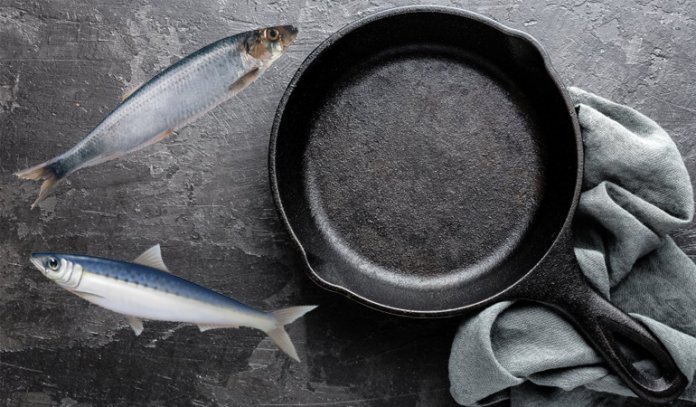A cast-iron pan is a staple in most kitchens. It provides optimal heating and is virtually indestructible. Moreover, when seasoned properly, the cooking surface possesses nonstick qualities.
The only problem is that cast iron pans can develop a strong and stinky odor, particularly fish smell when used to fry fish.
Contents
Luckily, it isn’t hard to combat the odor and deodorize your cast iron pan using different methods. Common solutions include boiling the pan in water, using baking soda, heating in the oven, and more!
6 Easy Ways to Get the Fish Smell Out of Cast Iron Pans
No one wants their pans to smell like fish! However, thanks to the porous surface of cast iron pans, smelly substances often make their way in. It can lead to stinky pans.
Moreover, the smell lingers even after you thoroughly wash your pan with soap and water. If you are also struggling with a smelly pan, here are a few tricks to eliminate the odor.
Boil the Pan in Water
One of the easiest ways to remove the stench of fish is to boil your cast iron pan in water.
Submerge the pan in boiling water for a few minutes. Heating the pan will help release the fish odor, which is then absorbed in the water. You can do it in two ways. Let’s take a look at both.
Boil Your Cast Iron Pan in water
Take a bigger pan or skillet that can hold your smelly pan. Fill it with water and place it on the stove. Refrain from filling it to the top to keep the water from spilling when you submerge the pan in it. Once the water starts to boil, slowly and carefully place the pan in it.
Let your cast iron pan sit in boiling water for about 15 to 20 minutes. Then remove the pan and discard the water into the sink. Fill the skillet again and place it on the stove and repeat the process.
Keep in mind that the fish smell is rarely eliminated in the first go. Therefore, repetition is often necessary.
Repeat the process as required until the pan is completely free of fish and other smells. It will also help you keep your pans clean and shiny from the outside.
Boil Water in Your Cast Iron Pan
This method is pretty easy and straightforward as compared to the first one. It will also get you the same results at removing the fish odor. However, it is not ideal for cleaning the pan from the outside.
To deodorize your cast iron pan, instead of submerging your pan in boiling water, simply boil some water within your iron skillet pan. Fill the pan with water halfway to the top. Place it on low heat and bring the water to boil.
Let the water boil for about 15 to 20 minutes. Then, carefully remove the pan from the stove and replace the boiling water with fresh water. Repeat the process as required to get rid of the fish odor completely.
Use Baking Soda
The baking soda works like a charm when it comes to removing unwanted odors from pans. It absorbs the odors to leave your pans smelling fresh and clean. Create a baking soda solution to clean your pan. You will need 5 parts water and 1 part baking soda to get the job done.
You can prepare the solution separately and pour it into the pan or prepare it directly in the pan. Either way, fill your cast iron pan with the baking soda solution and place it on an open flame.
Let the solution boil until most of the liquid evaporates. Depending on the size of your pan, it can take anywhere from 10 to 30 minutes.
As the solution boils, the pan will expand to release the stinky fish oil trapped in the porous surface. The baking soda in the solution will absorb it quickly, keeping it from leeching back into the pan.
To make sure the smell is eliminated, remove the pan from the flame while it still holds some baking soda solution at the bottom.
Let it rest overnight on the counter at room temperature. It will ensure that the baking soda extracts any remaining residue. The next day, wash your cast iron pan thoroughly with water.
You can also use mild soap to make sure all baking soda is removed. Let the pan dry and season it before using it for the best results.
Bake Your Pan in the Oven
This method is suitable for cast iron pans that are completely made of iron with no plastic or rubber parts. Baking the pan in the oven at a high temperature not only allows the pan to expand but also dries up the existing fish oil residue in the pan.
Set the heat to 350 degrees and place your smelly cast iron pan upside down in the oven. Heat the pan for about 30 to 45 minutes. Make sure you place your pan in the upside-down position to allow the fish oil residue to slip out of the pan and quickly dry due to high heat.
Carefully take the pan out of the oven after about 45 minutes. Let the pan cool and check for the smell. If the fish odor persists, stick your cast iron pan in the oven once more. Let it heat for another 30 minutes at about 350 degrees.
Fry White Vinegar Solution
Just like baking soda, white vinegar is an excellent smell-absorbing agent. It works the same way as baking soda to absorb fish oil residue. The best way to go about this method is to prepare a white vinegar solution.
Mix one part water into one part white vinegar in your cast iron pan. You can also prepare the solution separately and pour it into the pan.
Fill the pan with the solution almost halfway through and place it on an open flame. Bring the solution to a boil. Let the liquid boil for around 20 to 25 minutes before removing the pan from the stove.
Do not throw the remaining solution from the pan. Instead, let it sit at the bottom of the pan for a day. The household acid will fight the stinky fish odor to eliminate it completely overnight.
Once 24 hours or so have passed, discard the solution and wash the pan thoroughly with cold water. You may also use a mild soap if required. Dry the pan and season it before using.
Use Lemon Juice
Lemon juice helps clear the fish oil and the resulting unpleasant smell. Depending on your pan’s size, squeeze 3 to 4 lemons in the pan and add an equal quantity of water to prepare a lemon juice solution.
Set the pan aside for about an hour. It will allow the citric acid in the lemon juice to get the work and absorb most of the residue.
Next, place the pan on a burner or an open flame. Bring the solution to a boil and let it heat for a few minutes. The solution will neutralize any fish residue, providing in-depth cleaning.
Remove the pan from heat. Discard the remaining solution and wash your cast iron pan with cold water before cooking.
Re-Season Your Cast Iron Pan
Re-seasoning your pan can help you mask the smell of the fish. However, keep in mind that this method does not extract and remove the fish oil residue from the pan. Instead, it works by merely covering the fish odor with other strong smells, such as the odor of onions or garlic.
Clean the pan as thoroughly as possible. Remove the remaining oil or charred remains from the pan. Scrub the pan if required. You may have to use soap and water to clean it properly and remove all gunk. Once the cooking surface appears clean and dry, add olive oil to the pan.
Place the pan on the stove add a large-sized, freshly chopped onion in the pan. Next, add in some chopped garlic. Fry the contents on low heat until the contents are slightly charred. Remove the pan from heat and set it aside to let the contents of the pan cool.
Remove the charred onions and garlic from the pan and clean the cooking surface using a bunch of paper towels. At this point, the stinky smell of fish is likely to be replaced with the aroma of onions and garlic.
If the smell persists, try using another method before re-seasoning your pans to get rid of the smell for good.
The Bottom Line
Removing the unpleasant fish smell from your cast iron pans is not as challenging as you may have imagined.
Use the methods mentioned above to remove the odor easily and always enjoy cooking in clean and fresh cast iron pans and skillets.


